|
|
|
|
| Topanga
Beach - before the bulldozers
Except for the bright splashes of color on an old bougainvillea planted by the Bernstein family and Jimy Fitzpatrick, there are no tangible reminders of the houses that once stood side-by-side along the beachfront and PCH from the Charthouse restaurant to the creek. A dynamic beach community was bulldozed into oblivion to make way for another colorless, sterile State Beach. The people who formed the fabric of that community scattered, far and wide. But
once upon a time, before the |
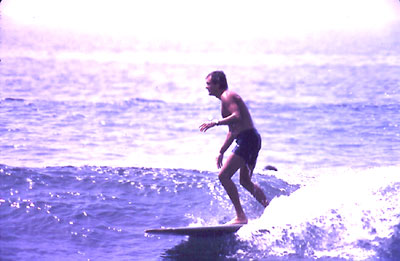 Me taking on a knee-high monster at Topanga Beach circa 1974 (then again, I've got very high knees) riding my personally signed 10'2" Greek surfboard, handcrafted in 1965 by Bob Bolen 'The Greek' of Huntington Beach - the board is still in the care of my friend Ron Normandeau with whom I left it when I headed for Aotearoa. Photo by Bob Herron |
Vintage Topanga Beach Facebook group: https://www.facebook.com/home.php?sk=group_172678689458477
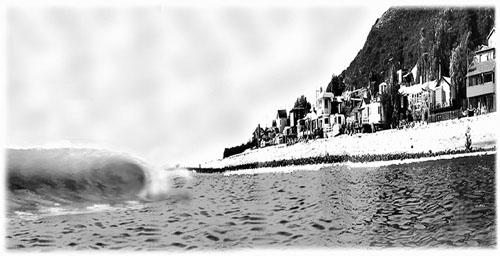 Original photo of Topanga Beach by Bob Herron PhotoShop image by Bill Cleary |
In the winter of 1959, Topanga Beach was still unexplored territory for me. Like Zero, Pt Dume, Latigo Cove and The Colony, Topanga was one of Malibu’s ‘closed’ beaches and ‘outsiders’ were not welcome. Public access was denied simply by virtue of these beaches being locked-in by land that was either privately or communally owned, like The Ranch is today. Private property rights extended down to the ‘mean high tide line’. The locals enforced the sovereignty of these lifestyle fiefdoms with fences, paid security guards, or, as in the case of Topanga, guerrilla warfare. |
|
Fortunately, school friends and locals I’d met made it possible for me to visit and surf the other beaches with impunity. But Topanga remained a mystery. Not that I was bothered. There was so much uncrowded surf between Punta Baja and Point Conception in those golden days that Topanga was just something else to file away for the future. Then one night at a party in up in Topanga Canyon, I met a Topanga Beach local named Bill Cleary. We got talking, swapping surf tales and generally ‘shooting-the-shit’. As the party broke up, Bill threw out a vague invitation to drop by his place on Topanga Beach sometime. |
|
The day I took him up on the offer was magic. One of those balmy winter days when the air is fresh and dry, and the sun has enough heat in it to tighten your face. I still had my ’53 Buick convertible, top down, board stuck behind the back seat just in case. As I sat at the traffic lights at PCH and Topanga Canyon Road, I had a feeling that I was about to embark on a new adventure. What I didn’t realize was what an impact this new adventure would have on the rest of my life. |
|
|
|
It’s hard to believe that winter traffic on PCH in 1959 was so light that I could easily turn left into the narrow lane that ran off from the highway and down behind the row of houses that lined the beachfront. I’d been told not to park on the beach side of the road because it was reserved for residents, so I had to drive almost to the bottom of the lane before I found a space big enough for my behemoth. With the exception of a single vacant lot, the line of houses up on the highway above the lane ran north along PCH to the bridge that still spans Topanga Creek today. But the houses across the lane along the beachfront formed a solid wall that stretched unbroken from the chain link fence on the highway at the entrance all the way down to the end of the road. Once you passed the fence you couldn’t even see the beach, let alone get to it. The lane also had the most eccentric assortment of vehicles I’d ever seen parked on any one road. My chrome encumbered Buick seemed out of place amongst the numerous Volkswagen bugs and campervans, not to mention an old Fiat, a Volvo station wagon, a Morris Minor ‘estate wagon’, a Mini, a couple of Renaults, an Anglia, Rover, two woodies, a Bedford van and an ancient Mercedes. There was even a strange looking Swedish-made thing called a Borgward and more than a few of the cars had surf racks. The tall redwood stake-fence that ran across front of Bill’s place had three entrances and, as instructed, I opened the gate on the left, started to walk in and scared myself shitless. The gate swung open directly over a steep set of old steps that ran straight down to a tiny brick courtyard ten feet below. As I held onto the gate for dear life, my feet dangled over the abyss until it swung back far enough for my toes to touch the ground again. What a welcome. What an entrance. Within a month I’d become the fourth roommate in Bill’s den of iniquity and could finally call Topanga Beach my home. |
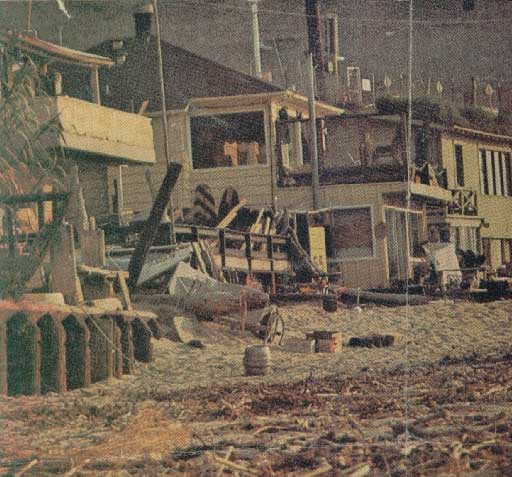 It's a bit of a mess at Southern end of Topanga Beach after an all-night party. Notice the chain link fence along the Pacific Coast highway at the top. Photo - courtesy of Michael Bender, who lived with his family in the house at the center of the photo. One of the beach's diaspora, Michael now lives in Puerto Vallarta, Mexico. |
On the beach When I first moved in I thought, "Fanfuckingtastic! I’m actually living on a surfing beach, with real live surf just outside my door." Girls, parties and surf , cha cha cha! But it didn’t take me long to discover that there was a lot more to Topanga Beach. First thing I learned was that every house at Topanga had a history of some sort, and Bill’s had the longest history of them all. Built in the 20's or 30's, the building once served as the ‘bathhouse’ for the exclusive Los Angeles Athletic Club. In fact, the LAAC still owned all the land along Topanga Beach and the houses, although privately owned, were sitting on leased property. Years later, the LAAC abandoned their Topanga Beach bathhouse and additional houses were built on individually leased parcels of beachfront until just about everything that could be built on was built on between what’s the Charthouse and the point. |
|
Somewhere along the line, the old bathhouse had been sold and divided up into three apartments: two on the ground floor and one huge, house sized apartment upstairs. Whereas the road side of Topanga Beach presented a solid defense against the uninvited, the beach side was warm and welcoming. Few, if any, residents bothered to lock their beachfront doors and it wasn’t unusual for an impromptu party to start in one house and move along the beach. Small boats and surfboards were left unguarded at the fronts and sides of houses up and down the beach and the people who owned them were, more often than not, generous about sharing. Unlike the Santa Monica
neighborhood where I grew up, I was getting to know all of my many
neighbors and, in an imperceptible way, becoming part of their lives.
The people themselves varied in age, occupations and interests. There
were families, couples, loners, and strays like myself. The only thing
we had in common was a mutual love of the beach and respect for the sea.
But that was enough. |
|
|
|
One family in particular welcomed me into their home. Jim Fitzpatrick (known to everyone as ‘Fitz’) was a charismatic person. Handsome, witty, patient and generous. His wife, Dody (known to many as ‘Mother of the Beach’) had a wicked sense of humor and a table that was never too small for extra guests. Then there was Jimmy, known then as ‘Jimy’ or ‘The Kid’ and now known as Jim or, like his late father, Fitz. If his energy and enthusiasm for life could have been harnessed, it would have solved the energy crisis overnight. Jimy’s younger sisters, Donna and Cathy, were quieter, but only just. Fitz was a film producer, director, editor and scriptwriter and the Fitzpatrick house was an energy center that saw a constant flow of fascinating people. |
|
Some, like Cleary, were embryonic writers. Others, like George Van Noy or Larry Kraus, were aspiring intellectuals who wanted to hone their debating skills. A few were already recognized and respected in professions such as photography, cinematography, music and art with the occasional mountain climber or gambler thrown in. Sometimes it was like a three-ring circus. On most nights, I’d sit safely on the sidelines in
order to watch and listen. Every once in a while I’d be unceremoniously
drawn in the discussion. And although these often became animated and
sometimes heated, they never got personal or malicious. This was a place
of ideas, conversation, laughter and discovery. It was, in a very special
way, a reflection of the diversity and intimacy of the larger community.
Because, more than anything else, Topanga Beach was a community - in every
sense of the word - and it was that which was the greatest loss when the
bulldozers came. |
|
 A rare photo of the beach before the old bathhouse burned down. (Photo - courtesy of Jeff Ort)
|
|
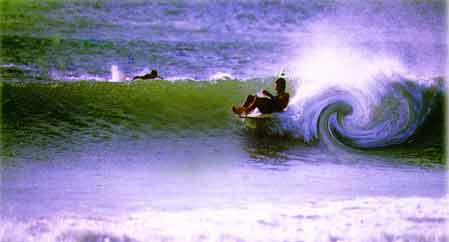 |
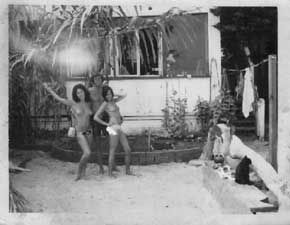
|
|
Malibu's undisputed 'Wavemaster' Miki 'Da Cat'
Dora on an early 60's |
Surfer, filmmaker & friend, the late |
|
Topanga Beach in the old
days. You'll notice that there are two bridges spanning Topanga Creek.
|
|
Today, there are no private houses, businesses or community left on either side of the highway. Today Topanga Beach, the Rodeo Grounds and Lower Topanga are part of what the pencil pushers, eco-fascists and political whores in Sacramento call a State Park. I call it a monument to bureaucratic arrogance and public gullibility ... because not only was it public money that was used to bankroll this shameful example of bureaucratic empire building - and continues to pay for park maintenance and staffing - but the public purse has also been made poorer by the loss of taxes that were generated by the very community The State destroyed. However, as a former public parasite
once said to me when I complained about his profligate waste of taxpayer's money, "Don't
worry ... there's always plenty more where that came from." |
|
Topanga Beach Before the Bulldozers © Robert R. Feigel, 2002 - All Rights Reserved |
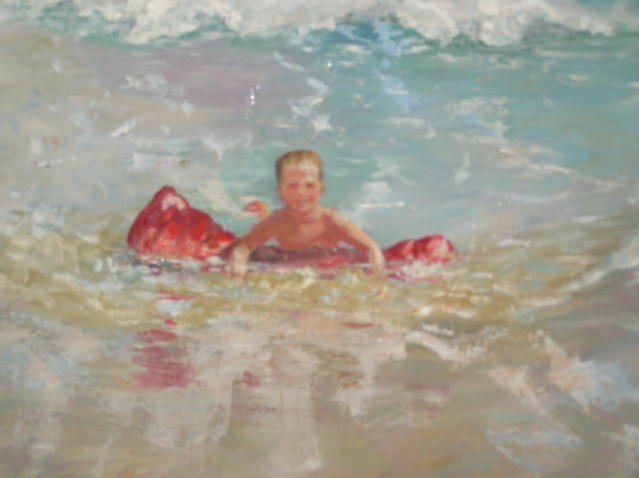 |
Woody
Woodward rides one of |
|
|
|
Watercolor |
|
|
|
|
| Some links to enjoy... | |
|
Vintage Topanga Beach Facebook group: https://www.facebook.com/home.php?sk=group_172678689458477 Notes from the Topanga Beach diaspora: https://surfwriter.net/notes_from_the_diaspora.htm Topanga Beach Stories: https://surfwriter.net/topangabeachstories_66-79.htm Surf Parties: http://atomicbride.com/surfparties.html Malibu Surf Photo History: http://atomicbride.com/tgraph.html Surfer's 'Talk Story': http://atomicbride.com/surfwrite.html LEGENDARY SURFERS: A
Definitive History of Surfing, by Malcolm Gault-Williams: http://www.legendarysurfers.com |
|